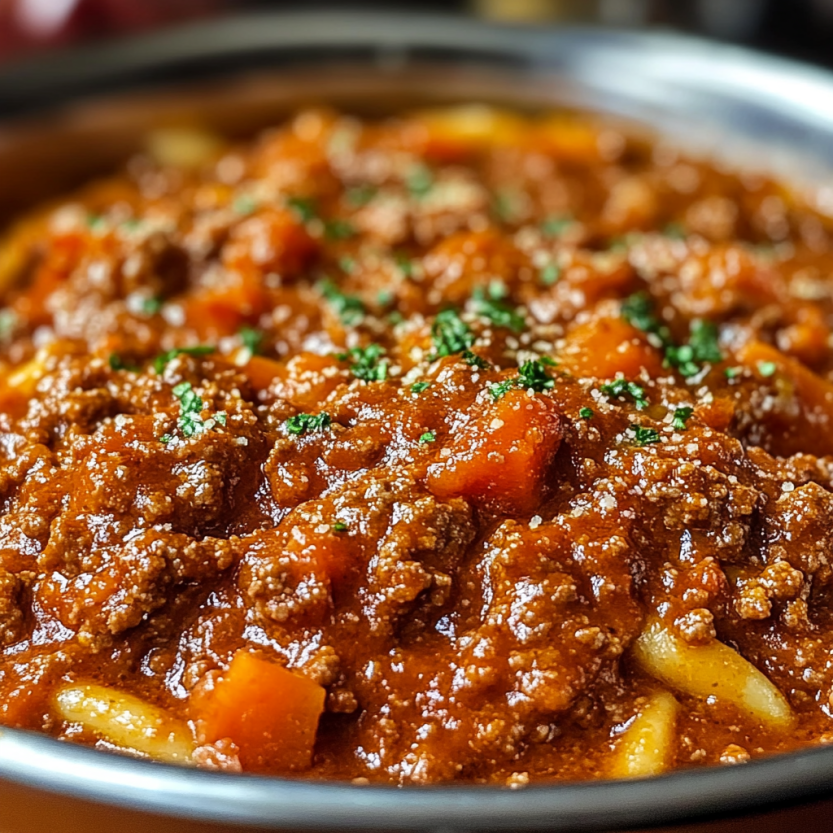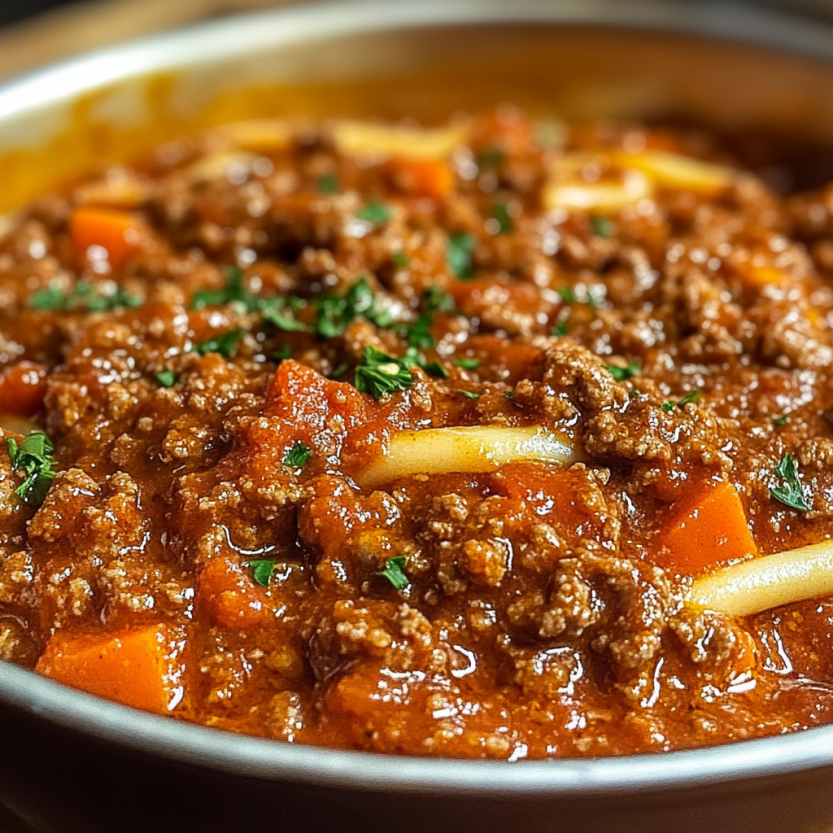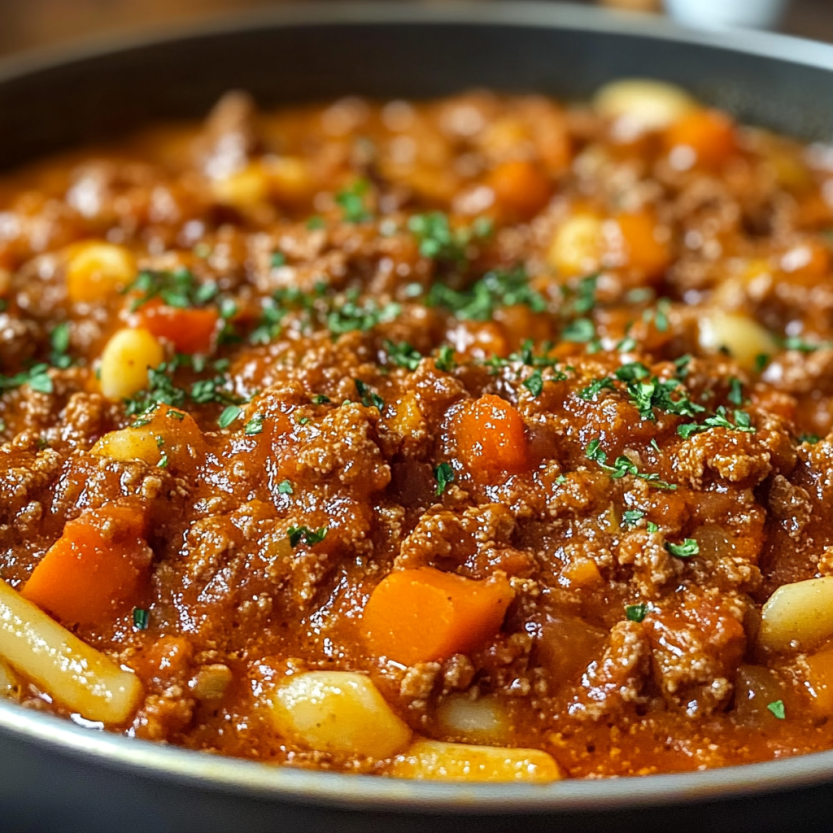 Bookmark
Bookmark
This hearty homemade Bolognese sauce has been my Italian cooking staple for years, combining the richness of two types of ground meat with aromatic vegetables and a slow simmer that creates incredible depth of flavor. The result is a versatile sauce that transforms any pasta dish from ordinary to extraordinary.
I first discovered this recipe during a cooking class in Bologna years ago. The chef emphasized that authentic Bolognese isn't about quick cooking but about patience. Now whenever my family smells this sauce simmering on a Sunday afternoon, they know something special is coming to the dinner table.
Ingredients
- Ground beef: provides the rich meaty foundation for this classic sauce; look for 80/20 fat content for the best flavor
- Ground pork: adds a subtle sweetness and keeps the sauce moist throughout cooking
- Onion, carrots, and celery: create the aromatic base known as soffritto in Italian cooking
- Garlic: brings essential aromatic depth; use fresh cloves rather than pre-minced for best results
- Tomato paste: concentrates the umami richness; look for double-concentrated tubes for maximum flavor
- Crushed tomatoes: provide the perfect texture; not too chunky and not too smooth
- Milk or cream: might seem unusual, but it tenderizes the meat and balances acidity
- Red wine: adds complexity and helps deglaze all the flavorful bits from the pan
- Bay leaves, oregano, and thyme: create that classic Italian herb profile
Step-by-Step Instructions
- Sauté the Soffritto:
- Heat olive oil in a large heavy-bottomed pot over medium heat until it shimmers but doesn’t smoke. Add the finely chopped onion, carrot, and celery mixture. Cook for a full 5 to 7 minutes, stirring occasionally, until the vegetables soften and the onions become translucent but not browned. This patient cooking of the vegetable base builds the foundation of flavor for the entire sauce.
- Add Aromatics:
- Add the minced garlic to the softened vegetables and cook for just 1 to 2 minutes, stirring constantly to prevent burning. You should smell the garlic becoming fragrant but not taking on any color. This brief cooking preserves the garlic’s aromatic qualities while removing its raw bite.
- Brown the Meats:
- Add both ground beef and ground pork to the pot, increasing the heat slightly to medium-high. Use a wooden spoon to break the meat into small pieces as it browns. This takes about 8 to 10 minutes and is crucial for developing flavor. Make sure to cook until no pink remains and you see some caramelization on some of the meat pieces, which adds tremendous depth.
- Deglaze with Wine:
- Pour the red wine into the pot, which will sizzle as it hits the hot surface. Use your wooden spoon to scrape up all the browned bits from the bottom of the pan; these contain concentrated flavor. Let the wine simmer for 3 to 5 minutes until it reduces slightly and the alcohol cooks off, leaving behind only the wine’s rich essence.
- Build the Sauce Base:
- Add the tomato paste and stir continuously for 1 to 2 minutes until it darkens slightly and becomes fragrant. This brief caramelization of the tomato paste develops umami richness that permeates the entire sauce. Then add the crushed tomatoes, milk or cream, herbs, and seasonings, stirring to combine everything thoroughly.
- Slow Simmer:
- Bring the sauce up to a gentle simmer then immediately reduce the heat to low. Cover partially, leaving a small gap for steam to escape, and let the sauce simmer for a full 1.5 to 2 hours. Stir occasionally, about every 20 minutes, to prevent sticking. During this time the sauce will thicken, the flavors will meld, and the meat will become incredibly tender.
- Final Seasoning:
- In the last 15 minutes of cooking, taste the sauce and adjust the seasonings with additional salt and pepper as needed. Remember to remove the bay leaves before serving as they are inedible. The finished sauce should be thick, rich, and deeply flavored.
 Bookmark
Bookmark
The milk ingredient might seem unusual but it's authentically Italian. My grandmother taught me this secret when I was young, saying the milk helps tenderize the meat proteins and balance the acidity of the tomatoes. I'll never forget watching her slowly pour cream into her simmering pot, insisting this was what separated good Bolognese from great Bolognese.
Storing Your Bolognese
Properly stored, Bolognese sauce can be a timesaver for multiple meals. After cooking, allow the sauce to cool completely before transferring to airtight containers. In the refrigerator, this sauce will maintain its quality for up to 4 days, becoming even more flavorful as the ingredients continue to meld. For longer storage, freeze in portion-sized containers or freezer bags laid flat for easier thawing. When ready to use, thaw overnight in the refrigerator and reheat gently on the stovetop, adding a splash of beef broth if needed to reach desired consistency.
Authentic Italian Variations
Traditional Bolognese from Bologna, Italy, differs from what many Americans expect. Authentic ragù alla bolognese contains very little tomato, using primarily meat, broth, milk, and just a touch of tomato for color and flavor. Some Italian grandmothers add chicken livers for richness, while others insist on using white wine instead of red. In Bologna, this sauce is traditionally served with tagliatelle pasta rather than spaghetti, as the flat ribbons hold the chunky sauce better. Consider trying these regional variations to experience different authentic versions of this beloved sauce.
 Bookmark
Bookmark
Perfect Pasta Pairings
While Americans often serve Bolognese with spaghetti, Italians prefer pasta shapes that can stand up to the hearty sauce. Tagliatelle, pappardelle, and fettuccine are excellent choices, as their wide, flat shapes give the sauce something to cling to. Rigatoni, penne, and other tubular pastas also work beautifully, as the meat can get trapped inside the tubes. For a truly special meal, try using this sauce in a homemade lasagna or as the filling for stuffed shells. Always reserve some pasta cooking water to help the sauce adhere better to your chosen pasta.
Frequently Asked Questions About Recipes
- → Can I make this Bolognese sauce ahead of time?
Absolutely! Bolognese sauce actually improves with time as the flavors continue to develop. Make it a day ahead and refrigerate it overnight for an even more flavorful result. It can be stored in the refrigerator for up to 4 days or frozen for up to 3 months.
- → What pasta shapes work best with Bolognese sauce?
Traditional Italian pairings include tagliatelle, pappardelle, or fettuccine, as the wide, flat noodles provide more surface area for the sauce to cling to. Rigatoni and penne are also excellent choices as their ridges and hollow centers capture the meaty sauce. Spaghetti is widely used, though less traditional.
- → Can I substitute the ground pork with something else?
Yes, you can substitute ground pork with ground veal for a more traditional Italian approach, or use all beef if preferred. For a lighter version, ground turkey or chicken can work, though the flavor profile will change. Whatever meat you choose, aim for at least 15-20% fat content to maintain richness.
- → Is the milk or cream really necessary in Bolognese sauce?
The milk or cream is a distinctive element in authentic Bolognese, adding richness and helping to tenderize the meat proteins. It also balances the acidity from the tomatoes and wine. While you can omit it for a dairy-free version, the sauce will have a different texture and flavor profile.
- → How can I make this Bolognese sauce more flavorful?
For deeper flavor, add a Parmesan rind during simmering (remove before serving), incorporate pancetta or bacon with the vegetables, use beef stock instead of some of the wine, or add mushrooms for umami. Fresh herbs like basil or a splash of balsamic vinegar at the end can also enhance the complexity.
- → Can I make this sauce in a slow cooker or Instant Pot?
Yes! For slow cooker, complete steps 1-5 on the stovetop, then transfer everything to the slow cooker and cook on low for 6-8 hours. For Instant Pot, use the sauté function for steps 1-5, then pressure cook for 20 minutes with a natural release. Both methods yield excellent results with less hands-on supervision.
